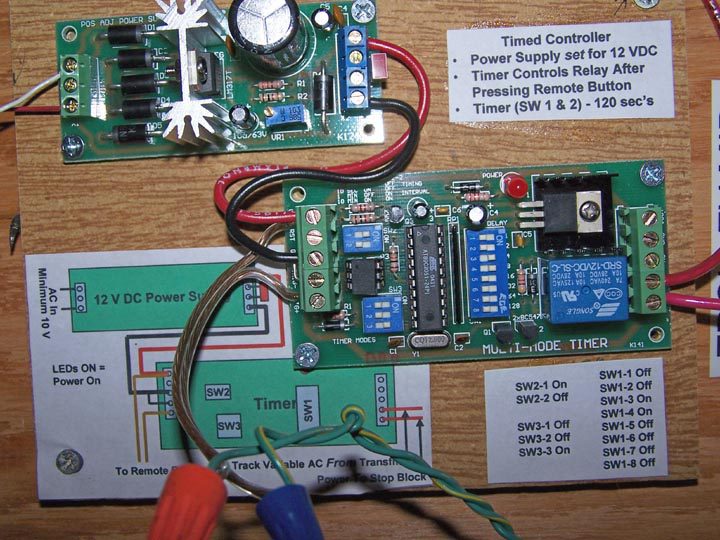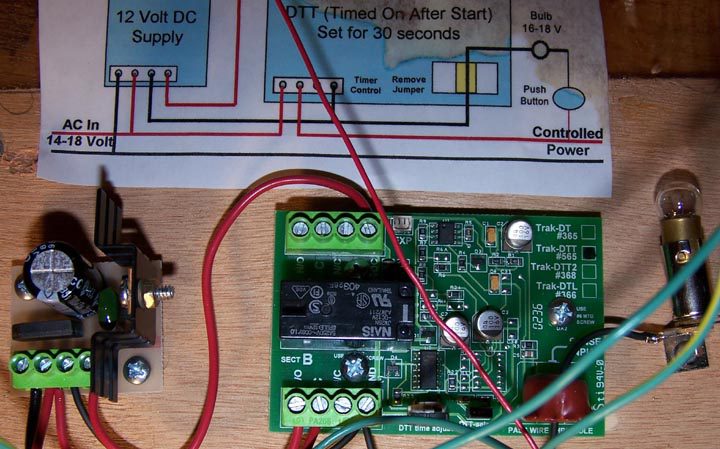Behind the Scenes at the TCA Museum – Buttons
By Roy Aydelotte-Co-Chair E&M Committee
Throughout the TCA Museum we have many buttons for kids of all ages to press. Most of the buttons (all but two) are on the layouts. The total number is around 25. Why so many? Why have buttons at all? The single biggest reason is to have something for the kids to press and then receive some form of instant gratification. And, we have a lot of kids visit the museum. Hopefully a few of the younger ones will grow up to become toy train enthusiasts and perhaps join TCA. A button sample is shown below from the S Gauge layout.
Throughout the year the Education and Museum (E&M) Committee members will replace most of the buttons at least once. Have you ever seen a kid try to press a button to start a train and the train is already going? They will continue to press and press to see if it will do anything else. And some of the kids (age 21+) have quite a bit of digital pressure! The poor buttons were designed for occasional use to ring door bells, but the cost is only a few dollars each thus keeping them affordable.
There are many applications used for these buttons. These include starting trains, creating action, flashing lights, and initiating a voice recorder. Over the past many years we have slowly added additional buttons to allow for interaction with Museum visitors. After all, most of the kids under ten are more interested in seeing something happen. Of course, we have many kids over 50 who enjoy them as well. The visitor only sees the button and the resulting action, but there may be quite a bit of electronics under the layout to actually make things happen.
Let’s take a look at what happens when someone starts a train. First you should understand that the automation for the different layouts was developed over the years and different methods have been used. The result is all basically the same. After the button is pushed, a timer starts and a relay is turned on. This provides power to the control block for the selected train. When the timer runs out, the relay turns off. The next time the train gets to the control block, it stops. The track outside of the block remains powered all the time. The O Gauge layout was the last to be converted to an electronic timer.
Previously we used a traffic control signal that would turn each train on for 10 minutes, then off for two. The timers now used allow the trains to rest when there are few visitors. This helps to reduce the wear on the trains and the maintenance load on the E&M Committee members. The electronics used are a combination of Dallee, LGB, and Carl’s Electronics control units. Each approach has its pros and cons, but they all work. The picture below shows one of the electronic boards (from Carl’s Electronics) used to control trains. Where feasible, we try to add information so the units may be serviced easily.
The only “train” that has more than one control block is the trolley line on the O Gauge layout; it has three along with reversing controls at each end of the line. In addition, on the O Gauge layout, there is a button that allows the visitor to stop the outside loop train at the station, and then let it go again. When this was first put in place several years ago, the E&M Chairman was found trying it out repeatedly late in the evening after most of the committee had retired. Just one more bit of proof that kids of all ages enjoy pushing the buttons.
We also use the buttons to start other actions. On the HO layout, two buttons allow the visitor to run a yard engine and cars between two points on a siding. On the rest of the layouts there are several items started with a button. This varies from starting a race car to controlling a lumber mill to starting oil pumps working. Some of these operate only when the button is depressed. Others start and are on a timer to allow things to work for 15-30 seconds. The oil derricks are an example of the last. Whenever a timer is used, there are the corresponding electronic boards and sometimes power supplies under the layout. Other examples are operating crossing lights, radar antennas, signal beacons, whistles and displays. The next picture shows the electronic boards (from Dallee) used to control the oil derricks on the O Gauge layout. The Lionel board in the base of the derrick requires a few seconds to start the pump action so a timer was used to ensure the action would start.
We have two buttons that initiate a recorder that provides audio information in two areas of our Historical Hall. Not sure where this is? As you come into the Museum, go around behind the 1928 Display and along the far wall you will find a hall with trains that date from the mid 1800’s to 1941. These recorders have not operated for the last few years as the displays have changed and resources were not available to update them. Both recorders are scheduled to be updated and enabled during the down time this winter.
The E&M Committee provides only occasional maintenance on the electronics under the various layouts. The usual problem is ensuring someone doesn’t turn down the accessory voltage so low that the electronics fail to operate. Then there are the couple of ballast lamps used on two of the layouts that burn out about once per year. Fixing either the electronics boards or the ballast lamp typically means opening up the control consoles at the side of the layout, or crawling underneath, to provide access and repair. Generally, there is nothing that doesn’t go wrong on the Museum layouts that doesn’t go wrong on a home layout. The primary difference is the work (and equipment) at the Museum has to be of such a caliber to provide very low maintenance between work sessions that only occur one a month. The kids are much more impressed when something happens (especially the older ones) when they push a button.
We are always looking for ways to add buttons. Or more specifically provide greater interaction for kids of all ages as they visit the National Toy Train Museum .
If you have some ideas, let us know.
Volunteers Needed! If these kinds of “behind the scenes” activities are of interest to you, drop me a line [email protected] or give me a call at 410-923-0754. We are always looking for TCA’ers with interest, talent, and/or the desire to learn to help out at our TCA Museum .









